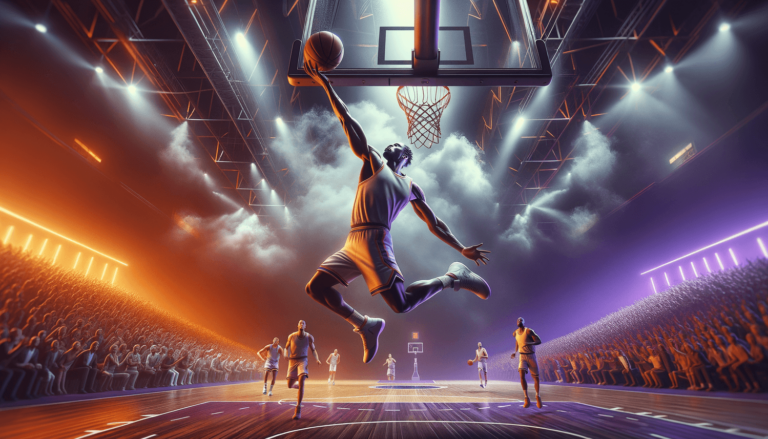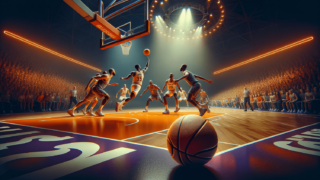
Ever watched a basketball game and witnessed a player execute a beautiful move that looked flashy and complex but left you baffled as to what just happened? Chances are you’ve witnessed a double-clutch layup, an advanced basketball technique that can leave defenders and spectators alike in awe. In this blog post, we’ll dive deep into the captivating world of double-clutch layups, breaking down its mechanics, uses, and significance within the game. Grab your favorite basketball gear and get ready to take your hoops knowledge to the next level as we demystify this fascinating and stylish maneuver!
What’s a Double-Clutch Layup in Basketball?
A double-clutch layup is an advanced basketball move where a player, while in mid-air, changes the ball’s trajectory before releasing it for a layup. This technique involves altering the timing of the shot by momentarily cradling the ball with both hands or moving it to one side before finishing the layup. The purpose of the double-clutch layup is to misdirect or avoid shot blockers and defenders, making it a valuable skill for players driving towards the basket in the midst of tight defense.
Unlocking the Art of the Double-Clutch Layup
There’s no doubt that the double-clutch layup is a crowd-pleaser, guaranteed to put fans on the edge of their seats. But for players looking to master this skill, there’s more to it than just its entertainment value. In this in-depth exploration of the double-clutch layup, we’ll break down the technique, its advantages, and how you can start practicing it right away to elevate your basketball game. Let’s dig in!
Anatomy of a Double-Clutch Layup
Before we delve into the mechanics, let’s first understand the key components of a standard layup, as it serves as the foundation for the double-clutch variation.
Standard Layup
In a traditional layup, a player dribbles towards the basket and jumps off their inside foot, extending their arm with the ball towards the hoop, then releasing the ball with a gentle touch towards the backboard. The standard layup is an essential basketball move and is often the first shot that players learn.
Double-Clutch Layup Components
The double-clutch layup takes things a step further by adding two main elements to the standard layup:
- Temporarily cradling the ball or moving it to the side while in mid-air
- Releasing the ball towards the basket with a higher degree of difficulty in terms of accuracy and timing
Why Use the Double-Clutch Layup?
The primary reason to use this technique is to make it more challenging for defenders to block your shot. By changing the timing and trajectory of your release while in the air, you can make it difficult for defenders to anticipate when and where the ball will be released. Additionally, the double-clutch can also create separation from defenders, allowing players to clear the path to the basket.
Evading Shot Blockers
In basketball, shot blockers are constantly lurking, eager to swat your shot away. By double-clutching, you make their job much harder. When they jump to block your standard layup, their momentum is already in motion, making it challenging to adjust to your last-second maneuver effectively.
Outlet for Creativity
Beyond its strategic importance, the double-clutch layup offers a canvas for players to showcase their creativity and flair on the court. The body control, hand-eye coordination, and athleticism required to execute this move successfully demonstrate a player’s skill and basketball IQ.
Breaking Down the Double-Clutch Layup Step by Step
Now that we understand the reasoning behind using a double-clutch layup let’s get into the nitty-gritty details of how to perform it.
Step 1: Approach the Basket
Bounce the ball aggressively, focusing on maintaining control and speed. As you approach the defenders, remain aware of their positioning and reading their intentions.
Step 2: Initiate the Jump
Just like with a standard layup, leap off your inside foot, propelling yourself upwards and towards the basket. Maintain a firm grip on the ball with both hands, preparing for the next step.
Step 3: Cradle or Shift the Ball in Mid-Air
While you’re airborne, momentarily cradle the ball with both hands or shift it to the side. This movement provides an opportunity to alter your shot’s timing and trajectory. Do this without interrupting your shot’s natural flow and maintaining body control.
Step 4: Adjust Your Arm Angle
As you release the ball, adjust your arm angle to account for the modified trajectory caused by the in-air ball movement. The goal is to make a smooth, accurate layup despite the added complexity of the double-clutch.
Step 5: Release the Ball
Complete the double-clutch layup by releasing the ball gently towards the backboard, targeting the ideal point where the ball will bounce and fall into the basket. Remember, accuracy and touch are key factors in a successful layup.
Practicing the Double-Clutch Layup
As with any basketball move, practice makes perfect. The dynamics of the double-clutch layup may take considerable time to master, but consistent practice will ultimately refine your skill. Here are some suggestions on how to train effectively:
Start with the Basics
It’s crucial first to have a strong foundation in traditional layups before attempting the double-clutch variation. Mastery of standard layups allows for better control and accuracy, two essential factors for success in double-clutch layups.
Break It Down into Separate Movements
Isolate each component of the double-clutch layup during practice. By focusing on specific movements, you gain a better understanding of the necessary adjustments to execute the move effectively. Gradually, begin combining these isolated movements into a fluid motion as your skills improve.
Use Drills to Improve Athleticism and Body Control
Incorporate drills that enhance your vertical leap, agility, and body control. The double-clutch layup demands a higher degree of athleticism compared to a standard layup, and these exercises will enable you to develop the skills necessary to execute the move successfully.
Practice with a Defender
While practicing alone is essential, replicating in-game scenarios by adding a defender can make a significant difference in improving your double-clutch proficiency. Start with a passive defender who allows you to work on your shot without intense pressure, and then gradually increase the level of defense as you become more comfortable with the move.
Taking Your Game to New Heights
The double-clutch layup is an advanced basketball move that can make a significant impact when executed correctly. By understanding its mechanics and diligently practicing the technique, you’ll be well on your way to elevating your game and dazzling spectators with your newfound skill. No matter your level of basketball experience, integrating the double-clutch layup into your arsenal can be a game-changer on the court.
Additional Tips and Considerations
To truly master the double-clutch layup, understanding the move’s intricacies and varying applications is essential. In this section, we’ll explore additional tips and considerations that will further refine your double-clutch layup technique and expand your skill set on the court.
Double-Clutch Layup Variations
There is more than one way to execute a double-clutch layup. Experimenting with different variations can help you develop an adaptable in-game strategy and make you less predictable on the court. Here are some popular double-clutch layup variations:
Reverse Double-Clutch Layup
This version of the double-clutch layup involves executing the move from the opposite side of the basket. The player initiates the layup on one side of the basket, clutches the ball, then switches to a reverse layup on the other side. This tactic can further confuse defenders while providing additional shot angles.
One-Handed Double-Clutch Layup
Advanced players may attempt one-handed double-clutches for added flair and difficulty. In this variation, the player shifts the ball to one hand during the clutch motion, releasing the layup with a single hand. While this approach boasts a higher degree of difficulty, it can further showcase your skills and dexterity if executed successfully.
Understanding the Limitations
While the double-clutch layup is undoubtedly an impressive and useful technique, it’s essential to recognize its limitations and know when to deploy this move. Overreliance on any single move, including the double-clutch, can render you predictable to opponents. Be aware of these limitations to make informed in-game decisions:
Increased Risk of Missed Shots
The added complexity of the double-clutch layup inherently increases the likelihood of a missed shot. The unconventional shifting of the ball and release angle makes it more challenging to maintain accuracy compared to a standard layup. Keep this in mind when deciding whether to attempt a double-clutch layup, especially in high-pressure situations.
Susceptibility to Steals and Defensive Adjustments
Opposing defenders, particularly those with a high basketball IQ, may adapt their defensive strategy to disrupt your double-clutch layup. Since the move requires additional time and movement to complete, defenders may target your vulnerable moments, such as the clutch, to steal the ball or force a turnover.
Learning from the Pros
One of the most effective ways to sharpen your double-clutch layup skills is to study professional players who excel at executing this move. Watching and analyzing their technique, timing, and decision-making can provide valuable insights into perfecting your double-clutch layup. Some players known for their double-clutch prowess include Michael Jordan, Kobe Bryant, and Kyrie Irving.
Final Thoughts
Mastering the double-clutch layup is a rewarding journey, as it not only adds another weapon to your offensive arsenal but also pushes you to develop and hone various basketball skills. By practicing diligently and understanding the intricacies and limitations of the double-clutch layup, you’ll be well on your way to becoming a more proficient and versatile basketball player.
Frequently Asked Questions
As you begin to explore the world of double-clutch layups in basketball, you may have several questions about this technique and its applications. We’ve compiled a list of frequently asked questions to help clarify any lingering doubts and provide you with insight and actionable information.
1. Is the double-clutch layup only for advanced players?
While the double-clutch layup is an advanced technique, any aspiring basketball player dedicated to improving their skills can attempt to learn it. Before diving into the double-clutch layup, ensure that you have a strong grasp of the basics and the standard layup.
2. Can smaller players use the double-clutch layup effectively?
Absolutely! Smaller players can benefit significantly from the double-clutch layup, as it helps neutralize the threat of taller shot blockers. The double-clutch layup can become a potent weapon in a smaller player’s arsenal if practiced and executed effectively.
3. How does the double-clutch layup differ from a standard layup?
The primary difference lies in the mid-air movement of the ball. While a standard layup is a simple, fluid motion towards the hoop, the double-clutch layup incorporates a temporary cradle or shifting of the ball during the jump. This change in trajectory and timing adds complexity and difficulty to the shot.
4. Are double-clutch layups more difficult for defenders to block?
Generally, yes. The altered timing and trajectory of a double-clutch layup make it challenging for defenders to anticipate the shot’s release, hence making it more difficult to block compared to a standard layup.
5. When should I use a double-clutch layup in a game?
Use a double-clutch layup when driving towards the basket with tight defense or when facing an aggressive shot blocker. This technique is valuable because it disrupts a defender’s expectations and can create opportunities for scoring. However, use it judiciously, as excessive reliance can make your offensive moves predictable.
6. How long does it take to master the double-clutch layup?
The time required to master the double-clutch layup varies depending on your skill level, athleticism, and dedication to practice. Regular, focused training can expedite the learning process and help you incorporate this technique into your gameplay more effectively.
7. Can practicing double-clutch layups improve my overall basketball skills?
Yes! Practicing double-clutch layups can significantly enhance several aspects of your game, including body control, hand-eye coordination, and athleticism. Additionally, it can improve your understanding of timing, accuracy, and shot adjustment, all of which contribute to your overall basketball skills.
8. Is it easier to execute a double-clutch layup from certain positions on the court?
Executing a double-clutch layup is generally easier when approaching the basket from a 45-degree angle, as it provides enough space and separation for the in-air ball movement. However, as you become more proficient in the technique, you may experiment and adapt to different angles and court positions for maximum effectiveness.
9. Can I use the double-clutch layup at any level of basketball competition?
Yes, the double-clutch layup can be used successfully at all levels of basketball competition, from recreational games to professional leagues. The key is to practice and execute the technique proficiently to leverage its tactical advantages during gameplay.
10. How can I track my progress while learning the double-clutch layup?
Track your progress by setting personal milestones and performing self-assessments of your technique, accuracy, and timing. Video recording your practice sessions can also help you analyze your movements and identify areas for improvement more effectively.
11. Is there any risk of injury when practicing the double-clutch layup?
As with any sport or athletic movement, there is some inherent risk of injury. Take preventive measures like proper warm-up, stretching, and conditioning exercises to minimize the risk. Also, maintain body control and awareness during practice sessions, and stop immediately if discomfort or pain arises.
12. How can I increase the height of my jump for a double-clutch layup?
To improve your vertical leap, incorporate plyometric and strength training exercises into your workout routine. Additionally, practice correct jumping form and technique to optimize your leap performance during a double-clutch layup.
13. Are there any specific drills for practicing the double-clutch layup?
While there are no dedicated double-clutch layup drills, you can incorporate the technique into existing layup drills or devise your customized drills focusing on isolating and combining the various components of the double-clutch layup. The key is consistent, targeted practice that challenges your skills and comfort level.
Featured Posts
- No pillar pages found.





